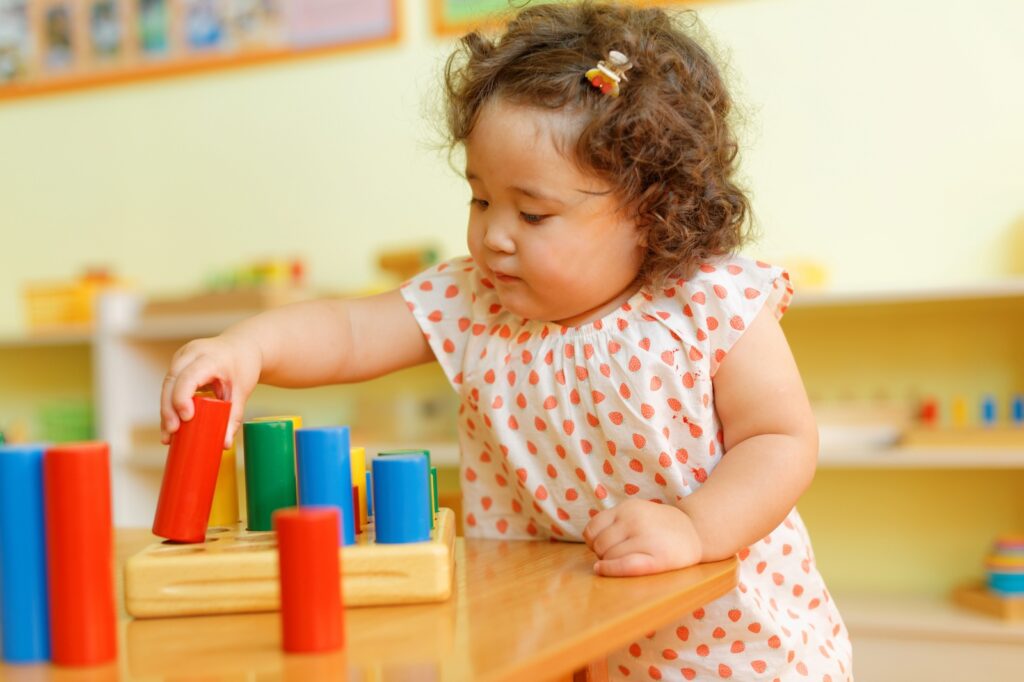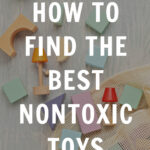How to Avoid Toxic Chemicals in Toys
Each birthday and holiday, parents are faced with the influx of new toys. As a conscious parent looking to find safer toys with minimal environmental impact, it’s hard to know where to look. Are we supposed to end up with a sad beige playroom filled with unpainted, unvarnished wooden toys?

Especially for babies and small kids who tend to put everything in their mouths, it’s super important to do the research to find safe, non toxic toys.
Toy Safety Goes Beyond Sharp Edges
Choking hazards and other accidental injuries are what mostly come to mind when we think about toy safety. But unfortunately there are risks we don’t consider.
Cheap toy cars and costume jewelry can be laced with lead, cadmium, arsenic, mercury and other dangerous metals that are harmful to growing kids, who are much more vulnerable to the effects of chemical exposure.
In February of 2009, the Consumer Product Safety Improvement Act adopted the ASTM F973-07 levels for antimony, arsenic, cadmium, mercury, lead, chromium standard, which limits levels of those chemicals in toys.
This may have passed. but that doesn’t mean that all toys are safe. The act didn’t incorporate the inclusion of Bisphenol-A, PVC, and many other chemicals so we still need to be conscious when we shop.
Here’s a deeper look at the safety of plastic toys.
Why are these chemicals in toys?
Plastics, fabrics and paints can contain a variety of substances in order to make them durable, flexible, or flame resistant. Sometimes it’s the byproduct of manufacturing process which can also be a great hazard to the people creating the products as well as disposal into the environment.
A 2013 study by Environmental Health News (EHN) found chemicals of high concern in thousands of toys – from plastic building blocks to dolls and baby accessories. The report shows children’s items from America’s largest companies contain low levels of dozens of harmful industrial chemicals including cobalt, ethylene glycol, bisphenol-A (BPA), phthalates, parabens, and mercury.
Chemicals to Watch Out For in Toys
Here are some of the most common and harmful chemicals found in toys that parents should avoid:
Phthalates
Phthalates are commonly added to plastics like PVC to make them flexible. These endocrine disruptors are linked to developmental, reproductive, and hormonal issues. Learn all about the dangers of different types of plastics in baby and kids toys here.
Found in: Soft plastic toys, dolls, teething rings, and inflatables.
PVC (Polyvinyl Chloride)
PVC is a type of plastic that can contain lead, cadmium, or phthalates, and its production and disposal release toxic dioxins into the environment. Here’s a deeper dive into the safety of PVC toys, especially for babies.
Found in: Plastic toys, dolls, inflatables, and teething toys.
BPA (Bisphenol-A)
BPA is used to harden plastics and is a known endocrine disruptor, potentially affecting brain and behavioral development in children.
Found in: Plastic toys, sippy cups, and bottles.
Lead
Lead can impair cognitive and physical development even at low levels and is particularly harmful to children’s growing brains. It can accumulate in the body over time, leading to long-term health issues. The Consumer Product Safety Commission (CPSC), the U.S. Public Interest Research Group (PIRG), and children’s health groups have found high levels of lead paint on older toys as well as in older vinyl lunch boxes, bibs, and children’s costume jewelry.
And since lead is a neurotoxin, it can permanently damage not only a child’s brain but their hearing and kidneys, as well.
Found in: Older toys, costume jewelry, and some vinyl products.
Ethylene Glycol
Ethylene glycol, the second most widely found chemical, showed up in more than 1,000 products. Commonly used as antifreeze and to make polyester and plastic water bottles, the EHN analysis also found ethylene glycol in baby feeding bibs, dolls, soft toys, educational and developmental toys, dress costumes, and games.
Health effects due to exposure of ethylene glycol may include developmental problems in humans (if oral exposures are high enough), airway irritation from breathing it for prolonged periods, and kidney damage.
Found in: Baby bibs, dolls, costumes, educational and developmental toys, games, and plastic toys.
Formaldehyde
Formaldehyde is often used in adhesives, wood composite materials, and some fabrics. It’s classified as a carcinogen and can irritate the respiratory system.
Found in: Wooden toys made from particleboard or plywood.
Flame Retardants
Brominated flame retardants (PBDEs) are linked to hormone disruption, neurodevelopmental delays, and cancer.
Found in: Stuffed toys, mattresses, car seats, and play mats.
Cobalt
Some of the most prevalent chemicals used by manufacturers came as a surprise, with cobalt being the most commonly reported. Cobalt is used in many blue dyes and other pigments and turned up in 1,228 products in 40 categories. Some health issues that may be caused by cobalt exposure include lung and other cancers, testicular atrophy, reduced fertility, and reduced organ function.
Found in: Blue dyes in paints and plastics.
Antimony
Antimony is used in flame retardants and as a catalyst in plastic production. Chronic exposure can cause respiratory irritation and organ damage.
Found in: Plastic toys and polyester-based materials.
VOCs (Volatile Organic Compounds)
VOCs such as toluene and benzene can cause respiratory irritation and long-term health risks.
Found in: Painted toys, craft kits, and art supplies.
Synthetic Fragrances
Fragrances in toys (like scented dolls or slime) often contain phthalates and chemicals that may trigger allergies or asthma.
Found in: Scented toys, slime, and art supplies.
EVA Foam
Ethylene-vinyl acetate (EVA) foam may contain formamide, which has been linked to developmental toxicity. Find more on avoiding EVA foam here.
Found in: play mats, puzzle mats, some foam building toys
How To Find Safer Toys
It can seem overwhelming, but there are many ways to shop for safer toys. There are several things you can look for when you start.
Check the Country of Origin
Many toys are made in China. After the onslaught of recalls in toys a few years ago (and continuing recalls) parents have been more aware of shopping for toys not made in China.
It’s not saying that all toys made in other countries are bad. But buying toys made locally has a positive effect on the economy, reduces the carbon footprint (think of all the overseas shipping you saved), and many times are smaller companies who put strict limits on testing. A perfect example is the company Green Toys. All of their toys are made in the U.S. from recycled milk jugs. When you can manage it, buy toys made in the USA or locally.
Shop Only With Trusted Retailers
Now that we do much of our shopping online, there are plenty of stores that only carry ethically made toys. With a little investigating, it’s easy to see that these online shops vet the toys they carry to make sure they are free of toxic chemicals. These green online shops are run by families just like yours.
They want nothing less for their own children and grandchildren, so their standards are as high as yours. They investigate every company and product in their shop with a scrutiny that mirrors my own. Wherever you like to shop online, investigate their standards and ask questions. Most shop owners are more than happy to tell you what you need to know.
Use Online Tools to Research & Check for Toy Recalls
There are a couple of ways to do a little research before you shop. These tools are the answer to everything but they can help a little bit with toy buying as well as monitoring the toys you already have.
Consumer Products Safety Commission’s website might seem like a no-brainer when it comes to checking into toy safety but even toys deemed safe can be recalled later on without you knowing about it. Select the infant/child recalls to keep up with toys and kids products.
Safer Toy Alternatives
All of this information sounds good, right? But when you’re in a hurry, you want links and options now. Here are toy brands that place a high priority on the safety and environmental impact of their toys.
Smiling Tree Toys
Green Toys
Haba USA
Bannor Toys
Imagine Childhood
Maple Landmark
Think and Grow Toys
The Puzzle People
Sarah’s Silks
For our curated safe toy lists, you’ll find gift and toy guides that are updated every year here:
Safe & Eco-Friendly Gifts for Kids
Natural Baby Gifts & Toys
Safe Gifts for Babies
Safe Gifts for Toddlers
Eco Friendly Gifts for Teens

